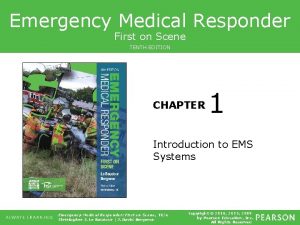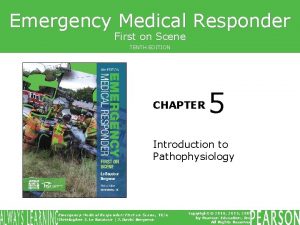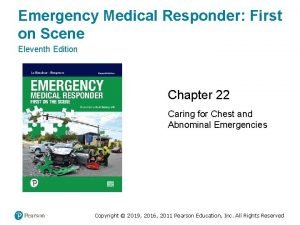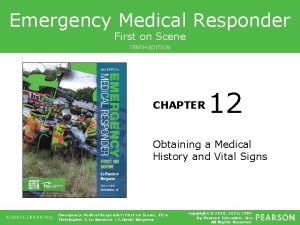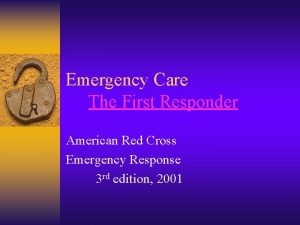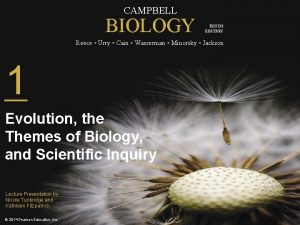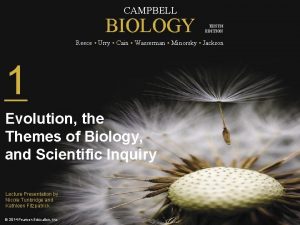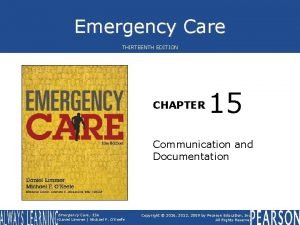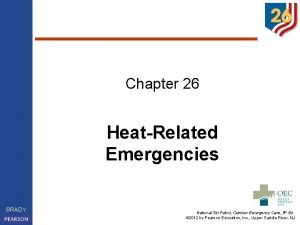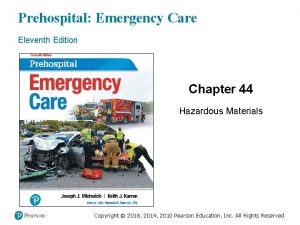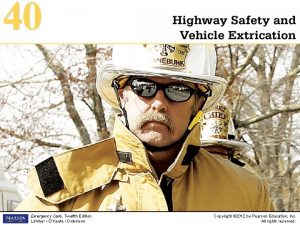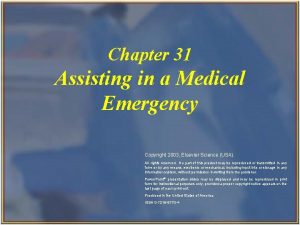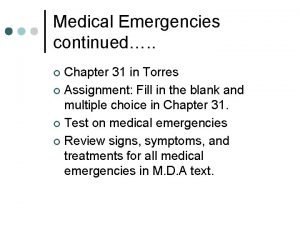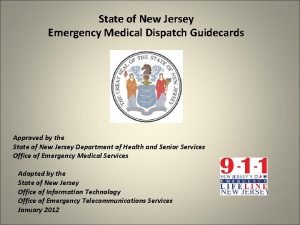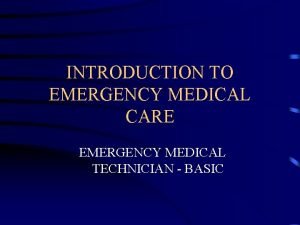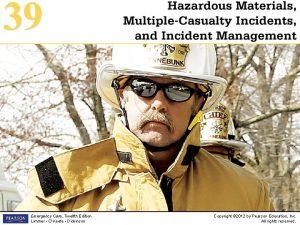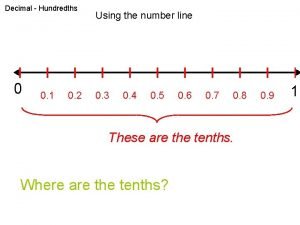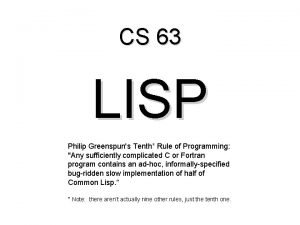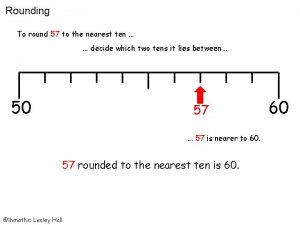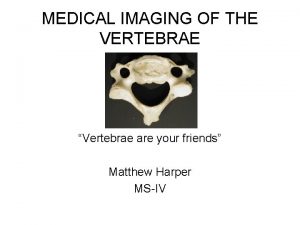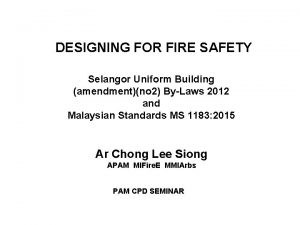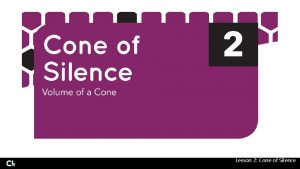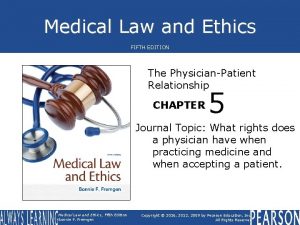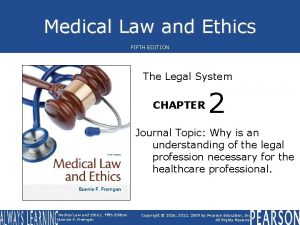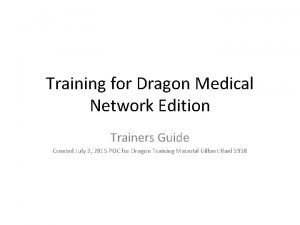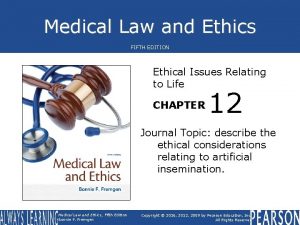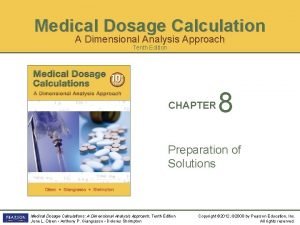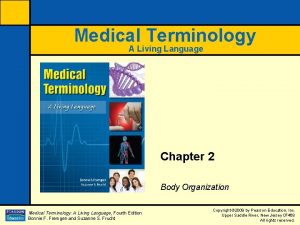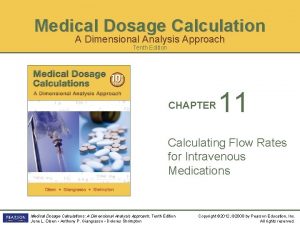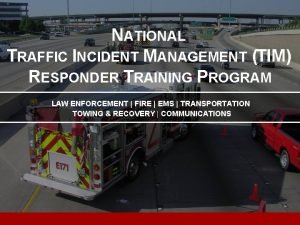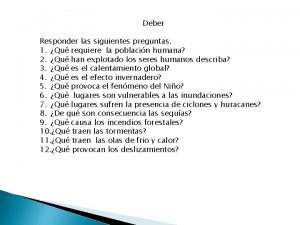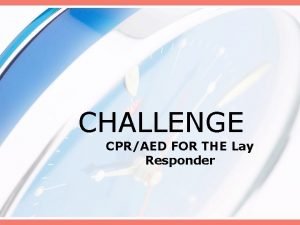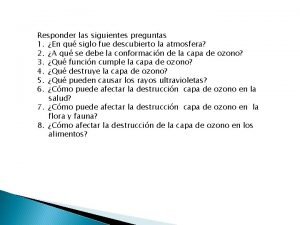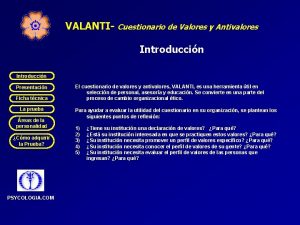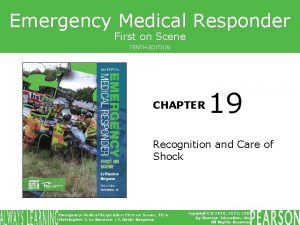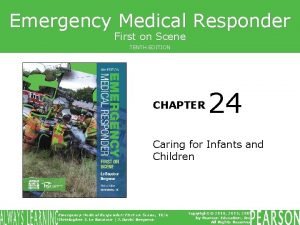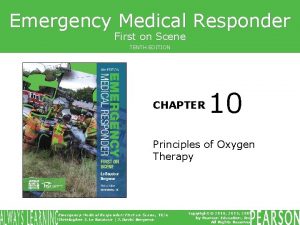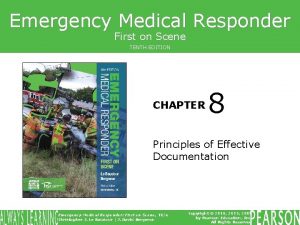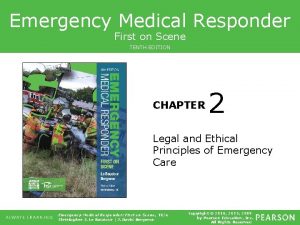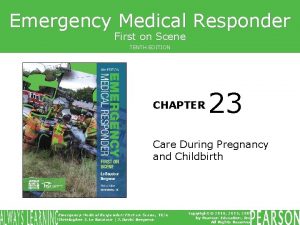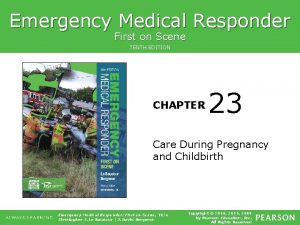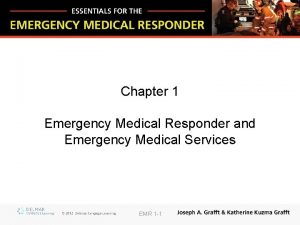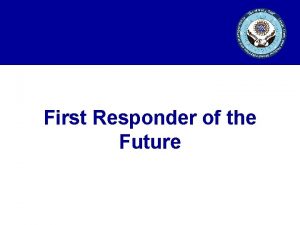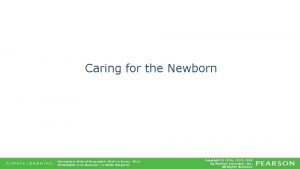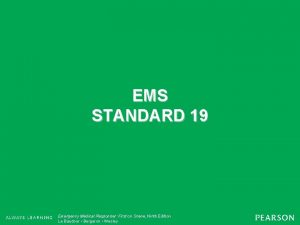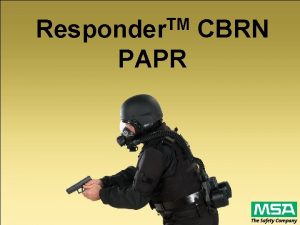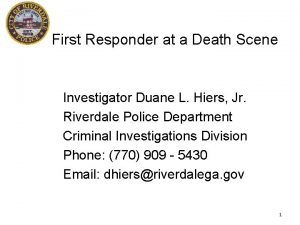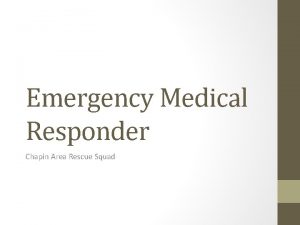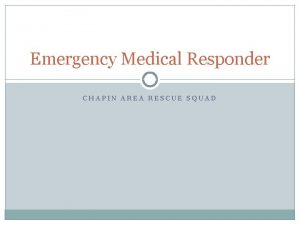Emergency Medical Responder First on Scene TENTH EDITION























































































- Slides: 87

Emergency Medical Responder First on Scene TENTH EDITION CHAPTER 22 Caring for Chest and Abdominal Emergencies Emergency Medical Responder: First on Scene, 10/e Christopher J. Le Baudour | J. David Bergeron Copyright © 2016, 2011, 2009 by Pearson Education, Inc. All Rights Reserved

Objectives 1. Review the anatomy of the chest and abdomen from Chapter 4. 2. Define the following terms: a. b. c. d. e. f. Closed chest injury Crepitus Diaphragm Distention Evisceration Flail chest Emergency Medical Responder: First on Scene, 10/e Christopher J. Le Baudour | J. David Bergeron continued on next slide Copyright © 2016, 2011, 2009 by Pearson Education, Inc. All Rights Reserved

Objectives 2. Define the following terms: g. Guarding h. Hemothorax i. Mediastinum j. Occlusive dressing k. Open chest injury l. Paradoxical movement m. Penetrating injury n. Pleura Emergency Medical Responder: First on Scene, 10/e Christopher J. Le Baudour | J. David Bergeron continued on next slide Copyright © 2016, 2011, 2009 by Pearson Education, Inc. All Rights Reserved

Objectives 2. Define the following terms: o. p. q. r. s. t. u. Pleural space Pneumothorax Quadrant Retroperitoneal cavity Spontaneous pneumothorax Sucking chest wound Tension pneumothorax continued on next slide Emergency Medical Responder: First on Scene, 10/e Christopher J. Le Baudour | J. David Bergeron Copyright © 2016, 2011, 2009 by Pearson Education, Inc. All Rights Reserved

Objectives 3. Describe the major structures of the thoracic cavity. 4. Explain the relationship between chest injury and perfusion. 5. Differentiate between an open and closed chest injury. 6. Describe the signs and symptoms of a closed chest injury. continued on next slide Emergency Medical Responder: First on Scene, 10/e Christopher J. Le Baudour | J. David Bergeron Copyright © 2016, 2011, 2009 by Pearson Education, Inc. All Rights Reserved

Objectives 7. Explain the appropriate assessment of a patient with a chest injury. 8. Explain the appropriate care of a patient with a closed chest injury. 9. Explain the appropriate care of a patient with an open chest injury. 10. Describe the major structures of the abdominal and pelvic cavities. continued on next slide Emergency Medical Responder: First on Scene, 10/e Christopher J. Le Baudour | J. David Bergeron Copyright © 2016, 2011, 2009 by Pearson Education, Inc. All Rights Reserved

Objectives 11. Describe the signs and symptoms of internal bleeding. 12. Explain the appropriate assessment and care of a patient with abdominal pain. 13. Explain the appropriate assessment and care of a patient with an open abdominal injury. continued on next slide Emergency Medical Responder: First on Scene, 10/e Christopher J. Le Baudour | J. David Bergeron Copyright © 2016, 2011, 2009 by Pearson Education, Inc. All Rights Reserved

Objectives 14. Demonstrate the appropriate assessment and care of a patient with a chest injury. 15. Demonstrate the appropriate assessment and care of a patient with abdominal pain. 16. Demonstrate the appropriate assessment and care of an open abdominal injury. continued on next slide Emergency Medical Responder: First on Scene, 10/e Christopher J. Le Baudour | J. David Bergeron Copyright © 2016, 2011, 2009 by Pearson Education, Inc. All Rights Reserved

Objectives 17. Value the importance of proper body substance isolation (BSI) precautions when assisting with chest and abdominal injuries. Emergency Medical Responder: First on Scene, 10/e Christopher J. Le Baudour | J. David Bergeron Copyright © 2016, 2011, 2009 by Pearson Education, Inc. All Rights Reserved

Media Directory Slide 25 Slide 26 Slide 50 Pneumothorax Animation Spontaneous Pneumothorax Animation Digestive System Animation Emergency Medical Responder: First on Scene, 10/e Christopher J. Le Baudour | J. David Bergeron Copyright © 2016, 2011, 2009 by Pearson Education, Inc. All Rights Reserved

Topics Anatomy of the Chest Injuries Abdominal Emergencies Abdominal Injuries Emergency Medical Responder: First on Scene, 10/e Christopher J. Le Baudour | J. David Bergeron Copyright © 2016, 2011, 2009 by Pearson Education, Inc. All Rights Reserved

ANATOMY OF THE CHEST Emergency Medical Responder: First on Scene, 10/e Christopher J. Le Baudour | J. David Bergeron Copyright © 2016, 2011, 2009 by Pearson Education, Inc. All Rights Reserved

Anatomy of the Chest • Chest cavity or thoracic cavity makes up approximately half of torso. • 12 pairs of ribs make the shape of the chest. • Major organs contained within chest are the heart and lungs. Emergency Medical Responder: First on Scene, 10/e Christopher J. Le Baudour | J. David Bergeron Copyright © 2016, 2011, 2009 by Pearson Education, Inc. All Rights Reserved

Anatomy of the Chest • Mediastinum houses the following: § § § Trachea Esophagus Heart Vena cava Aorta Emergency Medical Responder: First on Scene, 10/e Christopher J. Le Baudour | J. David Bergeron Copyright © 2016, 2011, 2009 by Pearson Education, Inc. All Rights Reserved

Figure 22. 1 The chest contains the heart and lungs and is separated from the abdominal cavity by the diaphragm muscle. Emergency Medical Responder: First on Scene, 10/e Christopher J. Le Baudour | J. David Bergeron Copyright © 2016, 2011, 2009 by Pearson Education, Inc. All Rights Reserved

Anatomy of the Chest • Left and right sides of chest are occupied by the lungs. § Pleura • Thin saclike structure that surrounds each lung § Pleural space • Potential space that exists between visceral and parietal pleura in chest Emergency Medical Responder: First on Scene, 10/e Christopher J. Le Baudour | J. David Bergeron Copyright © 2016, 2011, 2009 by Pearson Education, Inc. All Rights Reserved

Figure 22. 2 Each lung is surrounded by a thin lining of tissue called the pleura. Emergency Medical Responder: First on Scene, 10/e Christopher J. Le Baudour | J. David Bergeron Copyright © 2016, 2011, 2009 by Pearson Education, Inc. All Rights Reserved

Think About It • What might happen if a chest injury disrupts the parietal pleura? • What might happen if a lung injury disrupts the visceral pleura? • What if there is a problem with the fluid that provides lubrication between the pleural layers? Emergency Medical Responder: First on Scene, 10/e Christopher J. Le Baudour | J. David Bergeron Copyright © 2016, 2011, 2009 by Pearson Education, Inc. All Rights Reserved

CHEST INJURIES Emergency Medical Responder: First on Scene, 10/e Christopher J. Le Baudour | J. David Bergeron Copyright © 2016, 2011, 2009 by Pearson Education, Inc. All Rights Reserved

Chest Injuries • Closed Chest Injuries § Blunt force trauma • Blow to chest can fracture ribs, sternum, and rib cartilages. • • Falls Contact sports Vehicle collisions Blasts Emergency Medical Responder: First on Scene, 10/e Christopher J. Le Baudour | J. David Bergeron Copyright © 2016, 2011, 2009 by Pearson Education, Inc. All Rights Reserved

Chest Trauma • Open Chest Injuries § Penetrating injury • Penetrate chest wall, damaging internal organs and impairing respiration. • • • Bullet Knife Glass Steel rods Pipes Emergency Medical Responder: First on Scene, 10/e Christopher J. Le Baudour | J. David Bergeron Copyright © 2016, 2011, 2009 by Pearson Education, Inc. All Rights Reserved

Figure 22. 3 An open chest injury. (© Edward T. Dickinson, MD) Emergency Medical Responder: First on Scene, 10/e Christopher J. Le Baudour | J. David Bergeron Copyright © 2016, 2011, 2009 by Pearson Education, Inc. All Rights Reserved

Chest Injuries • Compression § Results from severe blunt trauma in which chest is rapidly compressed • Driver in motor-vehicle collision strikes chest on steering column. Emergency Medical Responder: First on Scene, 10/e Christopher J. Le Baudour | J. David Bergeron Copyright © 2016, 2011, 2009 by Pearson Education, Inc. All Rights Reserved

Chest Injuries • Closed Chest Injuries § Damage to ribs § Pneumothorax • Chest cavity filling with air from ruptured lung § Hemothorax • Blood from damaged soft-tissues and vessels enter chest cavity. Emergency Medical Responder: First on Scene, 10/e Christopher J. Le Baudour | J. David Bergeron Copyright © 2016, 2011, 2009 by Pearson Education, Inc. All Rights Reserved

Pneumothorax Animation Click on the screenshot to view an animation on the topic of pneumothorax. Back to Directory Emergency Medical Responder: First on Scene, 10/e Christopher J. Le Baudour | J. David Bergeron Copyright © 2016, 2011, 2009 by Pearson Education, Inc. All Rights Reserved

Spontaneous Pneumothorax Animation Click on the screenshot to view an animation on the topic of spontaneous pneumothorax. Back to Directory Emergency Medical Responder: First on Scene, 10/e Christopher J. Le Baudour | J. David Bergeron Copyright © 2016, 2011, 2009 by Pearson Education, Inc. All Rights Reserved

Figure 22. 4 Injured ribs can be splinted by securing bulky dressings tightly over the injured area. Emergency Medical Responder: First on Scene, 10/e Christopher J. Le Baudour | J. David Bergeron Copyright © 2016, 2011, 2009 by Pearson Education, Inc. All Rights Reserved

Chest Injuries • Closed Chest Injuries § Flail chest • Results when two or more ribs are broken in two or more places • Potentially life-threatening § Crepitus • Grating sound when bones rub together Emergency Medical Responder: First on Scene, 10/e Christopher J. Le Baudour | J. David Bergeron Copyright © 2016, 2011, 2009 by Pearson Education, Inc. All Rights Reserved

Figure 22. 5 A flail segment results when two or more adjacent ribs are fractured in two or more places. Emergency Medical Responder: First on Scene, 10/e Christopher J. Le Baudour | J. David Bergeron Copyright © 2016, 2011, 2009 by Pearson Education, Inc. All Rights Reserved

Chest Injuries • Closed Chest Injury Signs/Symptoms Pain on breathing Ecchymosis Increased difficulty breathing Accessory muscle use Uneven chest wall movement during breathing § Signs and symptoms of shock § § § Emergency Medical Responder: First on Scene, 10/e Christopher J. Le Baudour | J. David Bergeron Copyright © 2016, 2011, 2009 by Pearson Education, Inc. All Rights Reserved

Chest Injuries • Closed Chest Injury Management § Perform primary assessment. § Ensure ABCs are intact. § Provide positive pressure ventilations, if breathing is inadequate. § Remove clothing over area where there is complaint of pain. § Observe and palpate for signs of deformity. continued on next slide Emergency Medical Responder: First on Scene, 10/e Christopher J. Le Baudour | J. David Bergeron Copyright © 2016, 2011, 2009 by Pearson Education, Inc. All Rights Reserved

Chest Injuries • Closed Chest Injury Management § Administer oxygen per local protocols. § Splint chest using bulky dressings or towels. § Place patient in a position of comfort, if no suspected spine injury. § Care for shock. § Transport patient. Emergency Medical Responder: First on Scene, 10/e Christopher J. Le Baudour | J. David Bergeron Copyright © 2016, 2011, 2009 by Pearson Education, Inc. All Rights Reserved

Figure 22. 6 Use both hands to carefully and thoroughly palpate the chest for pain and deformity. Emergency Medical Responder: First on Scene, 10/e Christopher J. Le Baudour | J. David Bergeron Copyright © 2016, 2011, 2009 by Pearson Education, Inc. All Rights Reserved

Chest Injuries • Open Chest Injuries § Sucking chest wound • Open chest wound characterized by sucking sound each time patient inhales § Tension pneumothorax • Air builds up inside chest cavity, causing excessive pressure on one side of chest. Emergency Medical Responder: First on Scene, 10/e Christopher J. Le Baudour | J. David Bergeron Copyright © 2016, 2011, 2009 by Pearson Education, Inc. All Rights Reserved

Figure 22. 7 (A) Penetrating chest injuries can allow air and blood to enter the chest cavity. (B) A collapsed lung (spontaneous pneumothorax) can occur without outside trauma. Emergency Medical Responder: First on Scene, 10/e Christopher J. Le Baudour | J. David Bergeron Copyright © 2016, 2011, 2009 by Pearson Education, Inc. All Rights Reserved

Chest Injuries • Open Chest Injuries Management § Immediately seal with something that prevents air from entering wound, like gloved hand. § Take appropriate Standard Precautions. § Place an occlusive dressing directly over wound and hold it in place. § Provide high-flow oxygen. § Care for shock. Emergency Medical Responder: First on Scene, 10/e Christopher J. Le Baudour | J. David Bergeron Copyright © 2016, 2011, 2009 by Pearson Education, Inc. All Rights Reserved

Figure 22. 9 Place an occlusive dressing over an open chest wound, and tape it on three or four sides. Follow local protocols. Emergency Medical Responder: First on Scene, 10/e Christopher J. Le Baudour | J. David Bergeron Copyright © 2016, 2011, 2009 by Pearson Education, Inc. All Rights Reserved

Figure 22. 8 A SAM® chest seal, an example of a commercial chest seal. Emergency Medical Responder: First on Scene, 10/e Christopher J. Le Baudour | J. David Bergeron Copyright © 2016, 2011, 2009 by Pearson Education, Inc. All Rights Reserved

Chest Injuries • Impaled Chest Wounds § Impaled objects must be stabilized and left in place. § Take appropriate Standard Precautions. § Perform primary assessment. § Ensure ABCs are intact. § Assist ventilations as appropriate. continued on next slide Emergency Medical Responder: First on Scene, 10/e Christopher J. Le Baudour | J. David Bergeron Copyright © 2016, 2011, 2009 by Pearson Education, Inc. All Rights Reserved

Chest Injuries • Impaled Chest Wounds § Provide high-flow oxygen per local protocol. § Provide care for shock. § Initiate immediate transport. Emergency Medical Responder: First on Scene, 10/e Christopher J. Le Baudour | J. David Bergeron Copyright © 2016, 2011, 2009 by Pearson Education, Inc. All Rights Reserved

Figure 22. 10 Stabilize impaled objects using bulky dressings. Emergency Medical Responder: First on Scene, 10/e Christopher J. Le Baudour | J. David Bergeron Copyright © 2016, 2011, 2009 by Pearson Education, Inc. All Rights Reserved

Think About It • You respond to a residential home to find a 26 -year-old female who was struck by a felled tree which impacted her chest. • What are your concerns? • How do you proceed? Emergency Medical Responder: First on Scene, 10/e Christopher J. Le Baudour | J. David Bergeron Copyright © 2016, 2011, 2009 by Pearson Education, Inc. All Rights Reserved

ABDOMINAL EMERGENCIES Emergency Medical Responder: First on Scene, 10/e Christopher J. Le Baudour | J. David Bergeron Copyright © 2016, 2011, 2009 by Pearson Education, Inc. All Rights Reserved

Abdominal Emergencies • Anatomy of the Abdomen and the Pelvis § Diaphragm • Primary muscle of respiration • Divides chest cavity from abdominal cavity § Epigastric • Area below the ribs to just above the naval continued on next slide Emergency Medical Responder: First on Scene, 10/e Christopher J. Le Baudour | J. David Bergeron Copyright © 2016, 2011, 2009 by Pearson Education, Inc. All Rights Reserved

Abdominal Emergencies • Anatomy of the Abdomen and the Pelvis § Periumbilical • Area around the naval § Superpubic • Area below the naval to the pubic region continued on next slide Emergency Medical Responder: First on Scene, 10/e Christopher J. Le Baudour | J. David Bergeron Copyright © 2016, 2011, 2009 by Pearson Education, Inc. All Rights Reserved

Abdominal Emergencies • Anatomy of the Abdomen and the Pelvis § Parietal peritoneum • Thin layer of tissue lining the wall of the abdominal cavity § Visceral peritoneum • Thin layer of tissue lining most of the abdominal organs continued on next slide Emergency Medical Responder: First on Scene, 10/e Christopher J. Le Baudour | J. David Bergeron Copyright © 2016, 2011, 2009 by Pearson Education, Inc. All Rights Reserved

Abdominal Emergencies • Anatomy of the Abdomen and the Pelvis § Retroperitoneal cavity • Area behind abdominal cavity that contains kidneys and ureters continued on next slide Emergency Medical Responder: First on Scene, 10/e Christopher J. Le Baudour | J. David Bergeron Copyright © 2016, 2011, 2009 by Pearson Education, Inc. All Rights Reserved

Abdominal Emergencies • Anatomy of the Abdomen and the Pelvis § Quadrant • Used to identify location of pain during palpation • Right upper quadrant (RUQ) • Left upper quadrant (LUQ) • Right lower quadrant (RLQ) • Left Lower quadrant (LLQ) Emergency Medical Responder: First on Scene, 10/e Christopher J. Le Baudour | J. David Bergeron Copyright © 2016, 2011, 2009 by Pearson Education, Inc. All Rights Reserved

Figure 22. 11 For assessment purposes, the abdomen is divided into four quadrants. Emergency Medical Responder: First on Scene, 10/e Christopher J. Le Baudour | J. David Bergeron Copyright © 2016, 2011, 2009 by Pearson Education, Inc. All Rights Reserved

Digestive System Animation Click on the screenshot to view an animation illustrating the anatomy of the digestive system. Back to Directory Emergency Medical Responder: First on Scene, 10/e Christopher J. Le Baudour | J. David Bergeron Copyright © 2016, 2011, 2009 by Pearson Education, Inc. All Rights Reserved

Table 22. 1 Solid and Hollow Organs Emergency Medical Responder: First on Scene, 10/e Christopher J. Le Baudour | J. David Bergeron Copyright © 2016, 2011, 2009 by Pearson Education, Inc. All Rights Reserved

Abdominal Emergencies • Generalized Abdominal Pain § § § § Bleeding Infection Ulcers Indigestion Constipation Food poisoning Menstrual cramps continued on next slide Emergency Medical Responder: First on Scene, 10/e Christopher J. Le Baudour | J. David Bergeron Copyright © 2016, 2011, 2009 by Pearson Education, Inc. All Rights Reserved

Abdominal Emergencies • Generalized Abdominal Pain § § § Diabetic emergencies Kidney stones Gallstones Appendicitis Ectopic pregnancy Emergency Medical Responder: First on Scene, 10/e Christopher J. Le Baudour | J. David Bergeron Copyright © 2016, 2011, 2009 by Pearson Education, Inc. All Rights Reserved

Abdominal Emergencies • Acute Abdominal Pain Signs/Symptoms § § Pain that is either sharp or dull Pain on palpation Rigid or tight abdomen Bloating (distention) continued on next slide Emergency Medical Responder: First on Scene, 10/e Christopher J. Le Baudour | J. David Bergeron Copyright © 2016, 2011, 2009 by Pearson Education, Inc. All Rights Reserved

Abdominal Emergencies • Acute Abdominal Pain Signs/Symptoms § § Nausea/vomiting Cramping Pain that radiates to other areas Guarding • Protecting abdomen Emergency Medical Responder: First on Scene, 10/e Christopher J. Le Baudour | J. David Bergeron Copyright © 2016, 2011, 2009 by Pearson Education, Inc. All Rights Reserved

Figure 22. 12 A patient experiencing acute abdominal pain will often lie on her side and guard her abdomen. Emergency Medical Responder: First on Scene, 10/e Christopher J. Le Baudour | J. David Bergeron Copyright © 2016, 2011, 2009 by Pearson Education, Inc. All Rights Reserved

Abdominal Emergencies • Acute Abdominal Pain Assessment § Rule out history of trauma. § Injuries to abdomen cause bleeding that is very slow. § Signs and symptoms can be delayed for hours, sometimes days. § Obtain a thorough medical history. Emergency Medical Responder: First on Scene, 10/e Christopher J. Le Baudour | J. David Bergeron Copyright © 2016, 2011, 2009 by Pearson Education, Inc. All Rights Reserved

Think About It • You respond to the home of a 14 -yearold female. Her mother reports that she dismissed her from school because of severe abdominal pain. She attempted to take the girl to the pediatrician, but the pain had intensified and she is unable to walk. continued on next slide Emergency Medical Responder: First on Scene, 10/e Christopher J. Le Baudour | J. David Bergeron Copyright © 2016, 2011, 2009 by Pearson Education, Inc. All Rights Reserved

Think About It • The patient has no other medical history, takes no medication, and has no allergies. She has a pulse of 100, blood pressure of 90/60, and respiratory rate of 24. You palpate the abdomen and find the patient guarding her RLQ, so you palpate that quadrant last (gently). She screams out in pain. continued on next slide Emergency Medical Responder: First on Scene, 10/e Christopher J. Le Baudour | J. David Bergeron Copyright © 2016, 2011, 2009 by Pearson Education, Inc. All Rights Reserved

Think About It • What are your suspicions? • How will you proceed? • What other questions should you be sure to include in your assessment of this patient? Emergency Medical Responder: First on Scene, 10/e Christopher J. Le Baudour | J. David Bergeron Copyright © 2016, 2011, 2009 by Pearson Education, Inc. All Rights Reserved

ABDOMINAL INJURIES Emergency Medical Responder: First on Scene, 10/e Christopher J. Le Baudour | J. David Bergeron Copyright © 2016, 2011, 2009 by Pearson Education, Inc. All Rights Reserved

Abdominal Injuries • Abdominal injuries can produce lifethreatening emergencies. • Signs and Symptoms § Deep cut or puncture wound to abdomen, pelvis, or lower back § Blunt trauma to abdomen or pelvis § Pain or cramps in abdominal or pelvic region Emergency Medical Responder: First on Scene, 10/e Christopher J. Le Baudour | J. David Bergeron Copyright © 2016, 2011, 2009 by Pearson Education, Inc. All Rights Reserved

Abdominal Injuries • Signs and Symptoms § § § Guarding Lying still with legs drawn up Rapid, shallow breathing Rapid pulse Rigid, distended, and/or tender abdomen Emergency Medical Responder: First on Scene, 10/e Christopher J. Le Baudour | J. David Bergeron Copyright © 2016, 2011, 2009 by Pearson Education, Inc. All Rights Reserved

Abdominal Injuries • Caring for Closed Abdominal Injury § Perform thorough assessment of abdomen. § Palpate all quadrants. § Expose abdomen to observe for signs of injury. § Allow patient to maintain position of comfort. Emergency Medical Responder: First on Scene, 10/e Christopher J. Le Baudour | J. David Bergeron Copyright © 2016, 2011, 2009 by Pearson Education, Inc. All Rights Reserved

Abdominal Injuries • Abdominal Evisceration § Open wound of abdomen characterized by protrusion of intestines through abdominal wall • Never attempt to place spilled abdominal contents back into open wound. Emergency Medical Responder: First on Scene, 10/e Christopher J. Le Baudour | J. David Bergeron Copyright © 2016, 2011, 2009 by Pearson Education, Inc. All Rights Reserved

Figure 22. 14 An abdominal evisceration. (© Edward T. Dickinson, MD) Emergency Medical Responder: First on Scene, 10/e Christopher J. Le Baudour | J. David Bergeron Copyright © 2016, 2011, 2009 by Pearson Education, Inc. All Rights Reserved

22. 1. 1 Cut away clothing to expose the entire injury. continued on next slide Emergency Medical Responder: First on Scene, 10/e Christopher J. Le Baudour | J. David Bergeron Copyright © 2016, 2011, 2009 by Pearson Education, Inc. All Rights Reserved

22. 1. 2 Place a large sterile dressing moistened with sterile water or saline over the exposed abdominal contents. continued on next slide Emergency Medical Responder: First on Scene, 10/e Christopher J. Le Baudour | J. David Bergeron Copyright © 2016, 2011, 2009 by Pearson Education, Inc. All Rights Reserved

22. 1. 3 Place a plastic sheet over the dressing, and secure it in place. Emergency Medical Responder: First on Scene, 10/e Christopher J. Le Baudour | J. David Bergeron Copyright © 2016, 2011, 2009 by Pearson Education, Inc. All Rights Reserved

Think About It • You respond to a skateboard park where a 17 -year-old boy has fallen onto concrete from a 20 foot height following a failed ramp jump attempt. He's complaining of persistent LUQ abdominal pain and nausea. His friends tell you he tried to get up but felt lightheaded. continued on next slide Emergency Medical Responder: First on Scene, 10/e Christopher J. Le Baudour | J. David Bergeron Copyright © 2016, 2011, 2009 by Pearson Education, Inc. All Rights Reserved

Think About It • Your patient is left lateral recumbent, guarding his abdomen, and moaning in pain. He has no other medical history, takes no medication, and is allergic to penicillin. His pulse is 100, blood pressure 100/70, and respirations are 28. continued on next slide Emergency Medical Responder: First on Scene, 10/e Christopher J. Le Baudour | J. David Bergeron Copyright © 2016, 2011, 2009 by Pearson Education, Inc. All Rights Reserved

Think About It • What are your suspicions? • How will you proceed? • What else could be going on? Emergency Medical Responder: First on Scene, 10/e Christopher J. Le Baudour | J. David Bergeron Copyright © 2016, 2011, 2009 by Pearson Education, Inc. All Rights Reserved

SUMMARY Emergency Medical Responder: First on Scene, 10/e Christopher J. Le Baudour | J. David Bergeron Copyright © 2016, 2011, 2009 by Pearson Education, Inc. All Rights Reserved

Summary • Injuries to chest can affect ability of patient to breathe adequately and cause damage to internal organs. • Injuries to chest classified as either open or closed. • Types of closed injuries § Broken ribs § Collapse of a lung, pneumothorax § Blood in chest cavity, hemothorax continued on next slide Emergency Medical Responder: First on Scene, 10/e Christopher J. Le Baudour | J. David Bergeron Copyright © 2016, 2011, 2009 by Pearson Education, Inc. All Rights Reserved

Summary • Signs and Symptoms of Closed Chest Injuries § § § Pain on breathing Difficulty breathing Discoloration Deformity Paradoxical movement continued on next slide Emergency Medical Responder: First on Scene, 10/e Christopher J. Le Baudour | J. David Bergeron Copyright © 2016, 2011, 2009 by Pearson Education, Inc. All Rights Reserved

Summary • Flail Chest § Caused when two or more ribs are broken in two or more places • Compromises integrity of chest wall • Makes it very difficult for patient to breathe adequately continued on next slide Emergency Medical Responder: First on Scene, 10/e Christopher J. Le Baudour | J. David Bergeron Copyright © 2016, 2011, 2009 by Pearson Education, Inc. All Rights Reserved

Summary • Be sure to expose all areas and palpate thoroughly with both hands. • Consider high-flow oxygen when local protocols indicate. continued on next slide Emergency Medical Responder: First on Scene, 10/e Christopher J. Le Baudour | J. David Bergeron Copyright © 2016, 2011, 2009 by Pearson Education, Inc. All Rights Reserved

Summary • Open chest injuries result in sucking chest wound § Must be covered immediately with occlusive dressing • Stabilize all impaled objects and secure object in place. • Do not attempt to remove an impaled object. continued on next slide Emergency Medical Responder: First on Scene, 10/e Christopher J. Le Baudour | J. David Bergeron Copyright © 2016, 2011, 2009 by Pearson Education, Inc. All Rights Reserved

Summary • Abdomen and pelvis contain organs that are both hollow and solid. • Injuries to organs can cause organ failure and severe internal bleeding. continued on next slide Emergency Medical Responder: First on Scene, 10/e Christopher J. Le Baudour | J. David Bergeron Copyright © 2016, 2011, 2009 by Pearson Education, Inc. All Rights Reserved

Summary • Signs and Symptoms of Abdominal Emergency § § Pain Rigidity Distention Blood in vomit or feces continued on next slide Emergency Medical Responder: First on Scene, 10/e Christopher J. Le Baudour | J. David Bergeron Copyright © 2016, 2011, 2009 by Pearson Education, Inc. All Rights Reserved

Summary • Abdominal injuries classified as closed or open. • Closed injuries result in organ damage and/or severe bleeding. continued on next slide Emergency Medical Responder: First on Scene, 10/e Christopher J. Le Baudour | J. David Bergeron Copyright © 2016, 2011, 2009 by Pearson Education, Inc. All Rights Reserved

Summary • Abdominal evisceration is open wound that has allowed abdominal contents to spill out. § Cover with a sterile moist dressing and cover with plastic to minimize chances that exposed organs will dry out. Emergency Medical Responder: First on Scene, 10/e Christopher J. Le Baudour | J. David Bergeron Copyright © 2016, 2011, 2009 by Pearson Education, Inc. All Rights Reserved

REVIEW QUESTIONS Emergency Medical Responder: First on Scene, 10/e Christopher J. Le Baudour | J. David Bergeron Copyright © 2016, 2011, 2009 by Pearson Education, Inc. All Rights Reserved

Review Questions 1. What are the major structures of the thoracic cavity? 2. What is the relationship between chest injury and perfusion? 3. What is the difference between an open and closed chest injury? 4. What are the signs and symptoms of a closed chest injury? continued on next slide Emergency Medical Responder: First on Scene, 10/e Christopher J. Le Baudour | J. David Bergeron Copyright © 2016, 2011, 2009 by Pearson Education, Inc. All Rights Reserved

Review Questions 5. What is the appropriate assessment of a patient with a chest injury? 6. What is the appropriate care of a patient with a closed chest injury? 7. What is the appropriate care of a patient with an open chest injury? 8. What are the major structures of the abdominal and pelvic cavities? continued on next slide Emergency Medical Responder: First on Scene, 10/e Christopher J. Le Baudour | J. David Bergeron Copyright © 2016, 2011, 2009 by Pearson Education, Inc. All Rights Reserved

Review Questions 9. What are the signs and symptoms of internal bleeding? 10. What is the appropriate assessment and care of a patient with abdominal pain? 11. What is the appropriate assessment and care of a patient with an open abdominal injury? Emergency Medical Responder: First on Scene, 10/e Christopher J. Le Baudour | J. David Bergeron Copyright © 2016, 2011, 2009 by Pearson Education, Inc. All Rights Reserved

Please visit www. bradybooks. com and follow the Resource Central links to access content for this text. Emergency Medical Responder: First on Scene, 10/e Christopher J. Le Baudour | J. David Bergeron Copyright © 2016, 2011, 2009 by Pearson Education, Inc. All Rights Reserved
 Emergency medical responder first on scene 10th edition
Emergency medical responder first on scene 10th edition Emergency medical responder first on scene 10th edition
Emergency medical responder first on scene 10th edition Emergency medical responder first on scene 11th edition
Emergency medical responder first on scene 11th edition Antecubital
Antecubital Red cross first responder
Red cross first responder Campbell biology tenth edition
Campbell biology tenth edition Campbell biology tenth edition
Campbell biology tenth edition Campbell biology tenth edition
Campbell biology tenth edition Elementary statistics tenth edition
Elementary statistics tenth edition Floyd digital fundamentals
Floyd digital fundamentals Corporate finance tenth edition
Corporate finance tenth edition Psychology tenth edition in modules
Psychology tenth edition in modules Human genetics concepts and applications 10th edition
Human genetics concepts and applications 10th edition Corporate finance tenth edition
Corporate finance tenth edition Corporate finance tenth edition
Corporate finance tenth edition Corporate finance tenth edition
Corporate finance tenth edition Corporate finance tenth edition
Corporate finance tenth edition Campbell biology tenth edition
Campbell biology tenth edition The graph shows data from the light colored soil enclosure
The graph shows data from the light colored soil enclosure Clorosplastos
Clorosplastos Biology tenth edition
Biology tenth edition Law enforcement first responder
Law enforcement first responder The standards of prehospital emergency care
The standards of prehospital emergency care Pre-hospital communication
Pre-hospital communication Emergency care 13th edition chapter 1
Emergency care 13th edition chapter 1 Outdoor emergency care 6th edition
Outdoor emergency care 6th edition Prehospital care 11th edition
Prehospital care 11th edition Prehospital emergency care 11th edition study guide
Prehospital emergency care 11th edition study guide Prehospital emergency care 11th edition
Prehospital emergency care 11th edition Prehospital emergency care 11th edition
Prehospital emergency care 11th edition Using mis 10th edition
Using mis 10th edition Chapter 1
Chapter 1 Introduction to emergency medical care
Introduction to emergency medical care Chapter 31 assisting in a medical emergency
Chapter 31 assisting in a medical emergency Define medical emergency chapter 31
Define medical emergency chapter 31 Medical emergency student lectures
Medical emergency student lectures Nj emd guide cards
Nj emd guide cards Texas medicaid transportation
Texas medicaid transportation Introduction to emergency medical care
Introduction to emergency medical care Medical
Medical Introduction to emergency medical care
Introduction to emergency medical care The tenth man graham greene summary
The tenth man graham greene summary 205 to the nearest 10
205 to the nearest 10 Round off to the nearest ones place
Round off to the nearest ones place 750 rounded to the nearest hundred
750 rounded to the nearest hundred What is the hundredths place
What is the hundredths place Xkcd lisp
Xkcd lisp What college did morrie and mitch first meet
What college did morrie and mitch first meet 25 rounded to the nearest ten
25 rounded to the nearest ten Scotty dog labeled
Scotty dog labeled Pressurized hydrant system malaysia
Pressurized hydrant system malaysia Lesson 2 volume of cones
Lesson 2 volume of cones Tenth may dawned bright and clear
Tenth may dawned bright and clear Tenth chapter wired
Tenth chapter wired Injuries first aid
Injuries first aid Chapter 8 emergency care first aid and disasters
Chapter 8 emergency care first aid and disasters Medical law and ethics 5th edition
Medical law and ethics 5th edition Medical law and ethics 5th edition
Medical law and ethics 5th edition Dragon network edition
Dragon network edition Medical law and ethics 5th edition
Medical law and ethics 5th edition Sustical
Sustical Medical term for front and back
Medical term for front and back Medical dosage calculations a dimensional analysis approach
Medical dosage calculations a dimensional analysis approach Macbeth summary act 1
Macbeth summary act 1 Macbeth act 4 notes
Macbeth act 4 notes Como comenzar un correo formal
Como comenzar un correo formal Lane designation terminology
Lane designation terminology Iqcs new responder form
Iqcs new responder form Responder
Responder Crisis responder
Crisis responder Esten siempre preparados para responder
Esten siempre preparados para responder Que responder a un bienvenido
Que responder a un bienvenido National tim responder training test answers
National tim responder training test answers Adveischool opiniones
Adveischool opiniones Rescue breaths for child with pulse
Rescue breaths for child with pulse National tim responder training test answers
National tim responder training test answers Responder las siguientes preguntas
Responder las siguientes preguntas El peligro de rechazar el mensaje de dios
El peligro de rechazar el mensaje de dios Prueba valanti desarrollada
Prueba valanti desarrollada High responder crops of the green revolution
High responder crops of the green revolution Kinder- und hausmärchen first edition
Kinder- und hausmärchen first edition Ptal california medical board
Ptal california medical board Gbmc medical records
Gbmc medical records Hepburn osteometric board
Hepburn osteometric board Torrance memorial hospital medical records
Torrance memorial hospital medical records Cartersville medical center medical records
Cartersville medical center medical records Maturity continuum model by stephen
Maturity continuum model by stephen State space graph
State space graph
